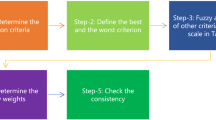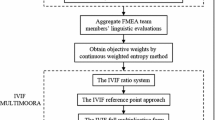Abstract
Failure modes and effects analysis (FMEA) is a commonly used step-by-step approach to assess potential failures existing in a product or process design. In this paper, a modified FMEA model based on an interval-valued spherical fuzzy extension of technique for order preference by similarity to ideal solution (IVSF-TOPSIS) is proposed to cope with drawbacks of the traditional risk priority number (RPN) computation. Spherical fuzzy sets are the integration of Pythagorean fuzzy sets and neutrosophic sets. They provide more freedom to experts in decision making by including the degree of membership, non-membership, and hesitation of fuzzy sets. Therefore, initially, TOPSIS is merged with a special branch of spherical sets “interval-valued spherical fuzzy sets” to determine priorities of emerged failures. As a novelty to traditional RPN of FMEA, three parameters called cost, prevention, and effectiveness in addition to the existed parameters of severity, occurrence and detection are attached to the proposed approach. Weights of these parameters are determined via an interval-valued spherical weighted arithmetic mean operator (IVSWAM). As a demonstration, a case study in a marble manufacturing facility is provided to show the applicability of the novel model. Results show that the most crucial failure modes concern with the maintenance and repairing works of the factory and the lack of technical periodic checks of lifting vehicles regarding “block area: crane” failures. Some comparative and validation studies are also performed to test the solidity of the approach.



Similar content being viewed by others
References
Akyuz E, Celik E (2018) A quantitative risk analysis by using interval type-2 fuzzy FMEA approach: the case of oil spill. Marit Policy Manag 45(8):979–994
Balin A (2020) A novel fuzzy multi-criteria decision-making methodology based upon the spherical fuzzy sets with a real case study. Iran J Fuzzy Syst 71:1–11
Başhan V, Demirel H, Gul M (2020) An FMEA-based TOPSIS approach under single valued neutrosophic sets for maritime risk evaluation: the case of ship navigation safety. Soft Comput 24:1–16
Baykasoğlu A, Gölcük İ (2020) Comprehensive fuzzy FMEA model: a case study of ERP implementation risks. Oper Res Int J 20(2):795–826
Bhattacharjee P, Dey V, Mandal UK (2020) Risk assessment by failure mode and effects analysis (FMEA) using an interval number based logistic regression model. Saf Sci 132:104967
Bian T, Zheng H, Yin L, Deng Y (2018) Failure mode and effects analysis based on D numbers and TOPSIS. QualReliabEngInt 34(4):501–515
Bozdag E, Asan U, Soyer A, Serdarasan S (2015) Risk prioritization in failure mode and effects analysis using interval type-2 fuzzy sets. Expert Syst Appl 42(8):4000–4015
Carpitella S, Certa A, Izquierdo J, La Fata CM (2018) A combined multi-criteria approach to support FMECA analyses: a real-world case. ReliabEngSystSaf 169:394–402
Catelani M, Ciani L, Venzi M (2018) Failure modes, mechanisms and effect analysis on temperature redundant sensor stage. ReliabEngSystSaf 180:425–433
Chai KC, Jong CH, Tay KM, Lim CP (2016) A perceptual computing-based method to prioritize failure modes in failure mode and effect analysis and its application to edible bird nest farming. Appl Soft Comput 49:734–747
Chen JK (2017) Prioritization of corrective actions from utility viewpoint in FMEA application. QualReliabEngInt 33(4):883–894
Di Bona G, Silvestri A, Forcina A, Petrillo A (2018) Total efficient risk priority number (TERPN): a new method for risk assessment. J Risk Res 21(11):1384–1408
Du Y, Lu X, Su X, Hu Y, Deng Y (2016) New failure mode and effects analysis: An evidential downscaling method. QualReliabEngInt 32(2):737–746
Ersoy M (2015) A proposal on occupational accident risk analysis: a case study of a marble factory. Hum Ecol Risk Assess Int J 21(8):2099–2125
Ersoy M, Eleren A, Kayacan S (2017) An application of failure mode and effect analysis on improving occupational health and safety process of marble factories. Int J Nat Disaster Health Secur 4(1):22–29
Fattahi R, Khalilzadeh M (2018) Risk evaluation using a novel hybrid method based on FMEA, extended MULTIMOORA, and AHP methods under fuzzy environment. Saf Sci 102:290–300
Fattahi R, Tavakkoli-Moghaddam R, Khalilzadeh M, Shahsavari-Pour N, Soltani R (2020) A novel FMEA model based on fuzzy multiple-criteria decision-making methods for risk assessment. J Enterp Inf Manag
Flores LS, Teixeira AR, Rosito LPS, Seimetz BM, Dall’Igna C (2016) Pitch and loudness from tinnitus in individuals with noise-induced hearing loss. Int Arch Otorhinolaryngol 20(03):248–253
Garg H, Munir M, Ullah K, Mahmood T, Jan N (2018) Algorithm for T-spherical fuzzy multi-attribute decision making based on improved interactive aggregation operators. Symmetry 10(12):670
Gul M, Ak MF (2020) Assessment of occupational risks from human health and environmental perspectives: a new integrated approach and its application using fuzzy BWM and fuzzy MAIRCA. Stoch Environ Res Risk Assess 34:1231–1262
Gul M, Yucesan M, Celik E (2020) A manufacturing failure mode and effect analysis based on fuzzy and probabilistic risk analysis. Appl Soft Comput 96:106689
Gül S (2020) Spherical fuzzy extension of DEMATEL (SF-DEMATEL). Int J Intell Syst 35(9):1329–1353
Gündoğdu FK, Kahraman C (2020a) A novel spherical fuzzy analytic hierarchy process and its renewable energy application. Soft Comput 24(6):4607–4621
Gündoğdu FK, Kahraman C (2020b) A novel spherical fuzzy QFD method and its application to the linear delta robot technology development. Eng Appl ArtifIntell 87:103348
Gündoğdu FK, Kahraman C, Karaşan A (2019) Spherical fuzzy VIKOR method and its application to waste management. In: International conference on intelligent and fuzzy systems. Springer, Cham, pp 997–1005
Guo J, Lin Z, Zu L, Chen J (2018) Failure modes and effects analysis for CO2 transmission pipelines using a hesitant fuzzy VIKOR method. Soft Comput 23:10321–10338
Harger MR, Barbosa-Branco A (2004) Effects on hearing due to the occupational noise exposure of marble industry workers in the Federal District, Brazil. Rev Assoc Med Bras 50:396–399
Hu YP, You XY, Wang L, Liu HC (2018) An integrated approach for failure mode and effect analysis based on uncertain linguistic GRA–TOPSIS method. Soft Comput 23:8801–8814
Huang J, Li ZS, Liu HC (2017) New approach for failure mode and effect analysis using linguistic distribution assessments and TODIM method. ReliabEngSystSaf 167:302–309
Huang Z, Jiang W, Tang Y (2018) A new method to evaluate risk in failure mode and effects analysis under fuzzy information. Soft Comput 22(14):4779–4787
Jiang W, Xie C, Zhuang M, Tang Y (2017) Failure mode and effects analysis based on a novel fuzzy evidential method. Appl Soft Comput 57:672–683
Kahraman C, Gundogdu FK, Onar SC, Oztaysi B (2019) Hospital location selection using spherical fuzzy TOPSIS. In: 2019 conference of the international fuzzy systems association and the European society for fuzzy logic and technology (EUSFLAT 2019). Atlantis Press.
Karaşan A, Boltürk E, Gündoğdu FK Assessment of livability indices of suburban places of Istanbul by using spherical fuzzy CODAS method. In: Decision making with spherical fuzzy sets. Springer, Cham, pp 277–293
Kasap Y, Sırakaya L (2019) Bir Mermer İşletmesinde Hata Türü Ve Etkileri Analizi Uygulaması. Soma Meslek Yüksekokulu Teknik Bilimler Dergisi 1(28):34–46
Kutlu Gündoğdu F (2020) A spherical fuzzy extension of MULTIMOORA method. J Intell Fuzzy Syst (Preprint), 1–16
Kutlu Gündoğdu F, Kahraman C (2019a) A novel fuzzy TOPSIS method using emerging interval-valued spherical fuzzy sets. Eng Appl Artif Intell 85:307–323
Kutlu Gündoğdu F, Kahraman C (2019b) Spherical fuzzy sets and spherical fuzzy TOPSIS method. J Intell Fuzzy Syst 36(1):337–352
Kutlu Gündoğdu F, Kahraman C (2019c) A novel VIKOR method using spherical fuzzy sets and its application to warehouse site selection. J Intell Fuzzy Syst 37(1):1197–1211
Kutlu Gundogdu F, Kahraman C (2019) Extension of WASPAS with spherical fuzzy sets. Informatica 30(2):269–292
Kutlu AC, Ekmekçioğlu M (2012) Fuzzy failure modes and effects analysis by using fuzzy TOPSIS-based fuzzy AHP. Expert Syst Appl 39(1):61–67
Li J, Fang H, Song W (2019) Modified failure mode and effects analysis under uncertainty: a rough cloud theory-based approach. Appl Soft Comput 78:195–208
Liu HC (2016) FMEA using uncertainty theories and MCDM methods. In: FMEA using uncertainty theories and MCDM methods. Springer, Singapore, pp 13–27
Liu HC, Chen XQ, Duan CY, Wang YM (2019) Failure mode and effect analysis using multi-criteria decision making methods: a systematic literature review. ComputIndEng 135:881–897
Liu HC, Liu L, Liu N (2013) Risk evaluation approaches in failure mode and effects analysis: a literature review. Expert Syst Appl 40(2):828–838
Lo HW, Liou JJ (2018) A novel multiple-criteria decision-making-based FMEA model for risk assessment. Appl Soft Comput 73:684–696
Lo HW, Liou JJ, Huang CN, Chuang YC (2019) A novel failure mode and effect analysis model for machine tool risk analysis. ReliabEngSystSaf 183:173–183
Lo HW, Shiue W, Liou JJ, Tzeng GH (2020) A hybrid MCDM-based FMEA model for identification of critical failure modes in manufacturing. Soft Comput 24(20):15733–15745
Mete S (2019) Assessing occupational risks in pipeline construction using FMEA-based AHP-MOORA integrated approach under Pythagorean fuzzy environment. Hum Ecol Risk Assess Int J 25(7):1645–1660
Ozceylan E, Ozkan B, Kabak M, Dagdeviren M (2020) A Survey on spherical fuzzy sets and clustering the literature. In: International conference on intelligent and fuzzy systems. Springer, Cham, pp 87–97
Ozdemir Y, Gul M, Celik E (2017) Assessment of occupational hazards and associated risks in fuzzy environment: a case study of a university chemical laboratory. Hum Ecol Risk Assess Int J 23(4):895–924
Özfirat MK, Özkan E, Kahraman B, Şengün B, Yetkin ME (2017) Integration of risk matrix and event tree analysis: a natural stone plant case. Sādhanā 42(10):1741–1749
Park J, Park C, Ahn S (2018) Assessment of structural risks using the fuzzy weighted Euclidean FMEA and block diagram analysis. Int J AdvManufTechnol 99:2071–2208
Perveen PAF, Sunil JJ, Babitha KV, Garg H (2019) Spherical fuzzy soft sets and its applications in decision-making problems. J Intell Fuzzy Syst (Preprint), 1–14.
Petrović DV, Tanasijević M, Milić V, Lilić N, Stojadinović S, Svrkota I (2014) Risk assessment model of mining equipment failure based on fuzzy logic. Expert Syst Appl 41(18):8157–8164
Qin J, Xi Y, Pedrycz W (2020) Failure mode and effects analysis (FMEA) for risk assessment based on interval type-2 fuzzy evidential reasoning method. Appl Soft Comput 89:106134
Reddy GT, Khare N (2017a) An efficient system for heart disease prediction using hybrid OFBAT with rule-based fuzzy logic model. J Circuits SystComput 26(04):1750061
Reddy GT, Khare N (2017b) Hybrid firefly-bat optimized fuzzy artificial neural network based classifier for diabetes diagnosis. Int J IntellEngSyst 10(4):18–27
Rezaee MJ, Salimi A, Yousefi S (2017) Identifying and managing failures in stone processing industry using cost-based FMEA. Int J AdvManufTechnol 88(9–12):3329–3342
Rezaee MJ, Yousefi S, Eshkevari M, Valipour M, Saberi M (2020) Risk analysis of health, safety and environment in chemical industry integrating linguistic FMEA, fuzzy inference system and fuzzy DEA. Stoch Env Res Risk Assess 34(1):201–218
Safari H, Faraji Z, Majidian S (2016) Identifying and evaluating enterprise architecture risks using FMEA and fuzzy VIKOR. J Intell Manuf 27(2):475–486
Seiti H, Fathi M, Hafezalkotob A, Herrera-Viedma E, Hameed IA (2020) Developing the modified R-numbers for risk-based fuzzy information fusion and its application to failure modes, effects, and system resilience analysis (FMESRA). ISA Trans. https://doi.org/10.1016/j.isatra.2020.01.015
Shishavan SAS, Gündoğdu FK, Farrokhizadeh E, Donyatalab Y, Kahraman C (2020) Novel similarity measures in spherical fuzzy environment and their applications. Eng Appl Artif Intell 94:103837
Tian ZP, Wang JQ, Zhang HY (2018) An integrated approach for failure mode and effects analysis based on fuzzy best-worst, relative entropy, and VIKOR methods. Appl Soft Comput 72:636–646
Tooranloo HS, Sadat Ayatollah A (2016) A model for failure mode and effects analysis based on intuitionistic fuzzy approach. Appl Soft Comput 49:238–247
Ullah K, Garg H, Mahmood T, Jan N, Ali Z (2020) Correlation coefficients for T-spherical fuzzy sets and their applications in clustering and multi-attribute decision making. Soft Comput 24(3):1647–1659
von Ahsen A (2008) Cost-oriented failure mode and effects analysis. Int J QualReliabManag 25(5):466–476
Wang L, Yan F, Wang F, Li Z (2020) FMEA-CM based quantitative risk assessment for process industries—A case study of coal-to-methanol plant in China. Process Saf Environ Prot 149:299–311
Yang Z, Li X, Garg H, Qi M (2020) Decision support algorithm for selecting an antivirus mask over COVID-19 pandemic under spherical normal fuzzy environment. Int J Environ Res Public Health 17(10):3407
Yoon K, Hwang CL (1981) Methods for multiple attribute decision making. In: Multiple attribute decision making: methods and applications a State-of-the-Art survey. Springer, Cham, pp 58–191
Yucesan M, Gul M (2019) Failure prioritization and control using the neutrosophic best and worst method. Granul Comput. https://doi.org/10.1007/s41066-019-00206-1
Zeng S, Garg H, Munir M, Mahmood T, Hussain A (2019) A multi-attribute decision making process with immediate probabilistic interactive averaging aggregation operators of T-spherical fuzzy sets and its application in the selection of solar cells. Energies 12(23):4436
Zhang H, Dong Y, Xiao J, Chiclana F, Herrera-Viedma E (2020) Personalized individual semantics-based approach for linguistic failure modes and effects analysis with incomplete preference information IISE Transactions 1–22
Zhao H, You JX, Liu HC (2017) Failure mode and effect analysis using MULTIMOORA method with continuous weighted entropy under interval-valued intuitionistic fuzzy environment. Soft Comput 21(18):5355–5367
Author information
Authors and Affiliations
Corresponding author
Ethics declarations
Conflict of interest
All authors declare that they have no conflict of interest.
Ethical approval
This article does not contain any studies with animals performed by any of the authors.
Additional information
Publisher's Note
Springer Nature remains neutral with regard to jurisdictional claims in published maps and institutional affiliations.
Rights and permissions
About this article
Cite this article
Gul, M., Ak, M.F. A modified failure modes and effects analysis using interval-valued spherical fuzzy extension of TOPSIS method: case study in a marble manufacturing facility. Soft Comput 25, 6157–6178 (2021). https://doi.org/10.1007/s00500-021-05605-8
Published:
Issue Date:
DOI: https://doi.org/10.1007/s00500-021-05605-8




